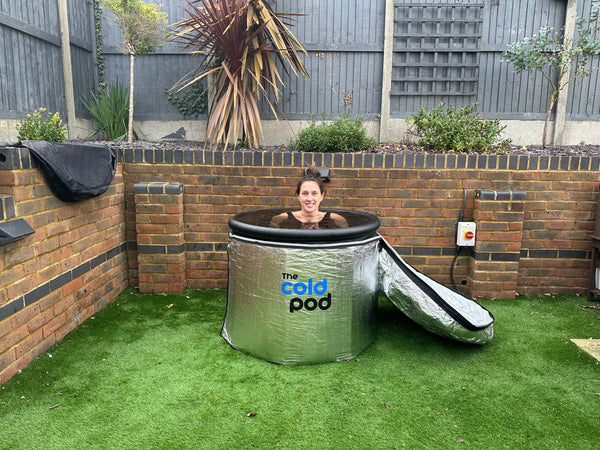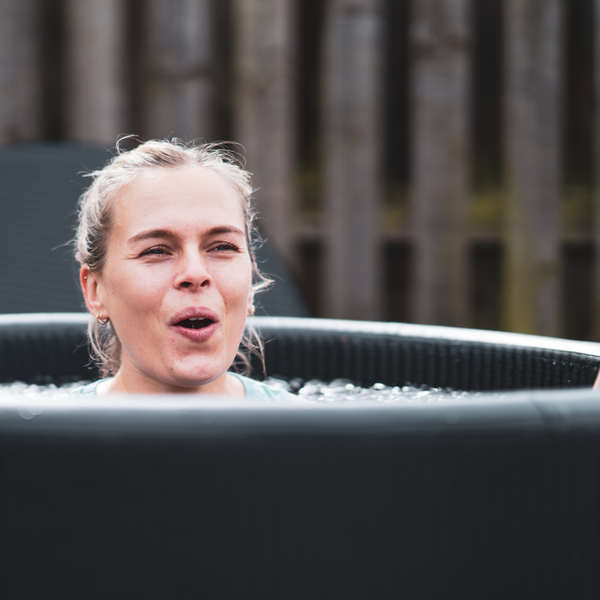Introduction
Winter has a unique way of capturing our senses—the crisp, invigorating air, the soft crunch of snow underfoot, and the sight of our breath billowing in the frigid atmosphere. While many of us prefer to stay bundled up indoors during these chilly months, there’s growing evidence that suggests there may be unexpected benefits to cold exposure in the cold.
In a world that often seeks comfort and warmth, the idea of voluntarily subjecting oneself to cold exposure might sound counterintuitive. However, as we delve into the science behind it, you’ll discover that wintertime wellbeing can be significantly enhanced by stepping out of your comfort zone and into the cold.
This blog explores the intriguing concept of cold dipping during the winter season. Additionally, how it can positively impact our health and overall sense of wellbeing. From the physiological responses that occur within our bodies to the psychological benefits of braving the cold. We’ll journey through the science behind it all. Whether you’re an adventurer seeking new challenges or simply someone looking to boost their mood during the colder months, this exploration of cold-water exposure is for you.
So, wrap up warm, grab a hot drink, and join us as we uncover the hidden benefits of cold exposure. Winter might just become your new season of rejuvenation and self-discovery.
The Science Behind Cold Exposure
As we brave the cold in the depths of winter, our bodies undergo a remarkable transformation. This transformation is a result of the physiological responses to cold temperatures. Hence understanding this science is crucial to unlocking the potential benefits of cold dipping.
Brown Adipose Tissue Activation (BAT)
At the heart of the cold exposure phenomenon is the activation of brown adipose tissue, or BAT. Unlike white adipose tissue (WAT), which stores excess energy in the form of fat, BAT plays a different role. It generates heat by burning calories, making it a powerful ally in the battle against weight gain. When you expose your body to cold, BAT gets to work, helping you stay warm and, in the process, burning calories.
Studies have shown that regular cold plunges can increase BAT activity, effectively turning your body into a calorie-burning furnace. This not only aids in weight management but also promotes overall metabolic health. So, next time you shiver in the cold, remember that your body is working to keep you warm while also helping you shed those extra pounds.
Endorphins and Mood Enhancement
Cold exposure isn’t just about physical changes; it also has a profound impact on your mental wellbeing. One of the reasons behind this is the release of endorphins, often referred to as “feel-good” hormones. When you expose yourself to cold temperatures, your body responds by releasing endorphins. Which can lead to an improved mood and a sense of euphoria.
These endorphins act as natural painkillers and stress relievers, helping to reduce symptoms of depression and anxiety. Cold dipping enthusiasts often report feeling more alert, focused, and emotionally resilient after cold sessions. It’s like a natural pick-me-up that you can experience in the midst of winter’s chill.
Understanding the science behind cold exposure is essential, as it demonstrates how the body adapts and thrives in challenging conditions. Armed with this knowledge, we can explore the numerous benefits that come with embracing the cold during the winter months.
Benefits of Cold Exposure in Wintertime
Winter often tempts us to seek warmth and comfort indoors. However, there’s increasing evidence suggesting that cold exposure may be the key to unlocking a range of health benefits during the chilly season. Let’s explore some of the advantages that cold dipping can offer for your wintertime wellbeing.
Improved Immune System
The winter season is notorious for its flu and cold outbreaks. However, cold water exposure may provide a surprising shield against illness. When you subject your body to cold temperatures, it triggers a response that strengthens your immune system. The stress caused by the cold prompts an increase in the production of white blood cells, which are essential for fighting off infections.
Additionally, cold plunging stimulates the production of a type of immune cell called natural killer cells. These cells are your body’s first line of defence against viruses and cancer cells. By regularly exposing yourself to the cold, you can potentially reduce the likelihood of falling ill during the winter months.
Increased Metabolism and Weight Management
As mentioned earlier, cold exposure activates brown adipose tissue (BAT), which is responsible for burning calories to generate heat. This increase in calorie burning can be a valuable asset for those looking to manage their weight. Even though it might be more tempting to stay indoors with comfort food, controlled cold exposure can help you maintain a healthier weight.
You don’t need to take icy plunges or endure extreme cold to reap the benefits. Simple practices like cold showers or outdoor activities in colder weather can stimulate your metabolism and contribute to weight management.
Enhanced Mood and Mental Wellbeing
The winter blues are a common experience for many. With shorter daylight hours and colder temperatures often leading to a dip in mood. However, cold water exposure can act as a natural mood enhancer. When your body is exposed to the cold, it releases endorphins—the body’s natural feel-good chemicals.
Endorphins not only reduce the perception of pain but also induce feelings of happiness and euphoria. This can help combat symptoms of depression and anxiety, which are often exacerbated during the winter season. Regular cold plunges can leave you feeling more positive, alert, and emotionally resilient, making the winter months a bit more enjoyable.
These benefits of cold exposure in wintertime demonstrate that there’s more to the chill in the air than meets the eye. By embracing the cold in a safe and controlled manner, you can potentially boost your immune system, manage your weight, and uplift your mood.
Safe Cold Exposure Practices
While the benefits of cold-water exposure in wintertime are enticing, it’s essential to approach this practice with caution and safety in mind. Cold dipping can be invigorating and health-enhancing when done correctly, but it can also be potentially harmful if undertaken recklessly. Here are some guidelines to ensure you stay safe while embracing the cold:
Start Gradually
If you’re new to cold-water exposure, don’t plunge headfirst into icy waters or endure prolonged exposure to freezing temperatures. Instead, start slowly and allow your body to acclimate over time. Begin with shorter exposures to milder cold conditions and gradually build up as your tolerance increases. This approach minimises the risk of shock to your system.
Dress Appropriately
When venturing into the cold, always wear appropriate clothing to protect your body from excessive cold and wind. Layering is key. Start with a moisture-wicking base layer to keep sweat away from your skin. Add an insulating layer for warmth, and finish with a windproof and waterproof outer layer. Don’t forget to protect your extremities with gloves, a hat, and warm socks.
Stay Hydrated and Nourished
Cold exposure can increase your body’s energy expenditure, so it’s crucial to stay hydrated and well-nourished. Drink warm liquids to help maintain your body temperature and eat nutritious, high-energy foods before and after exposure. This will provide your body with the fuel it needs to stay warm and recover effectively.
Listen to Your Body
Pay close attention to how your body reacts during cold exposure. If you experience severe shivering, numbness, confusion, or any signs of hypothermia, it’s essential to seek warmth immediately. Cold-water exposure should be challenging but not dangerous. Always prioritise your safety and well-being.
Consult a Healthcare Professional
Before incorporating cold plunges into your routine, especially if you have underlying medical conditions, it’s advisable to consult with a healthcare professional. They can provide guidance tailored to your specific needs and ensure that cold exposure is safe and appropriate for you.
Know When to Skip It
Cold exposure may not be suitable for everyone. If you have certain medical conditions like Raynaud’s disease, heart conditions, or respiratory issues, it’s best to avoid cold dipping or do so under strict medical supervision. Pregnant individuals and young children should also be cautious.
Remember that cold plunging should be an enjoyable and beneficial experience, not a risky endeavour. By following these safety practices, you can embrace the cold confidently and reap its rewards while safeguarding your health.
Practical Tips for Incorporating Cold Exposure
Now that we’ve explored the science behind cold dipping and its potential benefits, you might be wondering how to make this practice a part of your daily routine. Incorporating cold exposure doesn’t mean you have to take an ice bath every day. There are manageable and enjoyable ways to embrace the cold during the winter months:
Cold Showers
One of the simplest ways to introduce cold exposure into your routine is by taking cold showers. Start with your regular warm shower and gradually decrease the water temperature towards the end. The shock of the cold water can be invigorating, and over time, you can increase the duration of the cold portion of your shower. It’s a refreshing way to start your day and boost your metabolism.
Outdoor Activities
Engage in outdoor activities during colder weather. This could include brisk walks, jogging, cycling, or even hiking in winter landscapes. Being in the great outdoors during winter not only exposes you to colder temperatures but also allows you to enjoy the beauty of the season. Just be sure to dress appropriately and follow safety guidelines for outdoor activities.
Cold Water Swimming
For the more adventurous, cold-water swimming can be an exhilarating experience. Seek out cold-water lakes, rivers, or the sea and take a dip. However, always exercise caution and ensure you’re well-prepared for this activity. Start with short dips and gradually extend the duration as your body adjusts. Alternatively, you could try an ice bath like our Cold Pod
Contrast Therapy
Consider alternating between hot and cold exposure in a practice known as contrast therapy. After a hot bath or sauna, immerse yourself in a cold shower or a cold plunge pool for a short period. Then repeat the cycle. This contrast can enhance circulation, stimulate the immune system, and leave you feeling refreshed.
Winter Sports
Engaging in winter sports like skiing, snowboarding, or ice skating provides an excellent opportunity for cold-water exposure. These activities not only expose you to the cold but also offer the added benefit of physical exercise, which can further boost your metabolism and mood.
Deep Breathing and Mindfulness
Practicing deep breathing and mindfulness exercises can help you manage the discomfort associated with cold exposure. Learning to stay calm and focused during cold plunging can enhance your overall experience and make it more enjoyable.
Remember, the key is to start slowly and gradually increase the intensity and duration of your cold exposure activities. Listen to your body and do what feels comfortable for you. Cold dipping should be a positive and manageable addition to your routine, enhancing your wintertime wellbeing rather than causing stress.
FAQs About Cold Exposure
As we delve deeper into the world of cold plunging and its potential benefits, you might have some burning questions. Let’s address some of the most common queries about this intriguing practice:
Is cold exposure safe for everyone?
Cold-water exposure can be safe for most individuals when done responsibly and in moderation. However, it may not be suitable for people with certain medical conditions such as Raynaud’s disease, heart problems, or respiratory issues. Pregnant individuals and young children should also exercise caution. If you have concerns about your health and cold exposure, please consult a healthcare professional before embarking on this practice.
How long should I expose myself to the cold?
The duration of cold exposure can vary widely depending on your tolerance and experience level. For beginners, starting with just a few minutes of exposure is advisable, gradually increasing the time as your body adapts. Experienced cold enthusiasts may stay exposed for longer periods, but it’s crucial to listen to your body and avoid overexertion.
What’s the ideal temperature for cold exposure?
There isn’t a specific temperature that defines cold-water exposure, as it can vary from person to person. Generally, cold exposure is defined as exposure to temperatures below what your body is accustomed to. This might mean a brisk autumn day for some or sub-zero temperatures for others. The key is to challenge your body’s comfort zone while maintaining safety and comfort.
Can cold exposure help with weight loss?
Cold exposure can potentially aid in weight management by increasing metabolism and calorie burning. However, it’s not a magic solution for weight loss. To achieve significant weight loss, you’ll need to combine cold plunging with a balanced diet and regular exercise.
Are there any risks associated with cold exposure?
While cold dipping can offer numerous benefits, there are some potential risks. Prolonged exposure to extreme cold without proper clothing or acclimation can lead to hypothermia or frostbite. It’s vital to be aware of these risks and take precautions to avoid them.
Can I practice cold dipping daily?
The frequency of cold exposure can vary from person to person. Some individuals incorporate it into their daily routines, while others do it a few times a week. The key is to find a frequency that works for you and doesn’t cause excessive discomfort or stress on your body.
What’s the best way to warm up after an ice bath?
After a session of cold exposure, it’s essential to warm up gradually to avoid temperature shock. Warm clothing, a hot beverage, or a warm bath or shower can help raise your body temperature safely. Pay attention to how your body responds and ensure you’re fully warm before resuming normal activities.
Conclusion
As we draw the curtains on our exploration the benefits of cold exposure and wintertime wellbeing, it’s evident that the cold has much more to offer than meets the eye. Beyond the initial shivers and discomfort, there lies a realm of benefits waiting to be unlocked.
Throughout this blog, you’ve learned that cold plunging can be a valuable addition to your wintertime wellbeing toolkit. It has the potential to strengthen your immune system, support weight management, and improve your mental health—all while allowing you to embrace the unique charm of winter.
But remember, the key to successful cold exposure lies in responsible practice. Start slowly, dress appropriately, and listen to your body. Always prioritise safety and consult a healthcare professional if you have any doubts about whether cold-water exposure is suitable for you.
As we conclude, we invite you to take the first step towards embracing the cold this winter. Whether you choose to start with a brisk cold shower, a walk in the crisp air, or a new winter sport. Know that the chill of winter can become a season of rejuvenation and self-discovery. It’s time to step out of your comfort zone and into the cold for a healthier, happier winter.
Thank you for joining us on this journey of wintertime wellbeing through cold exposure. Stay warm, stay safe, and may the cold bring you a new sense of energy and strength in the days ahead.
Additional Resources
As we conclude our exploration of the benefits of cold exposure and its potential for wintertime wellbeing, we’d like to provide you with a list of additional resources. These resources can serve as valuable references and tools for those interested in learning more about cold exposure, ice baths, and related topics:
Online Communities and Forums
The Cold Pod Community: Website
Cold Exposure and Ice Bath Resources
The Cold Pod: Blog
Cold Exposure Therapy: Benefits, Risks, and How to Do It Safely: Blog







